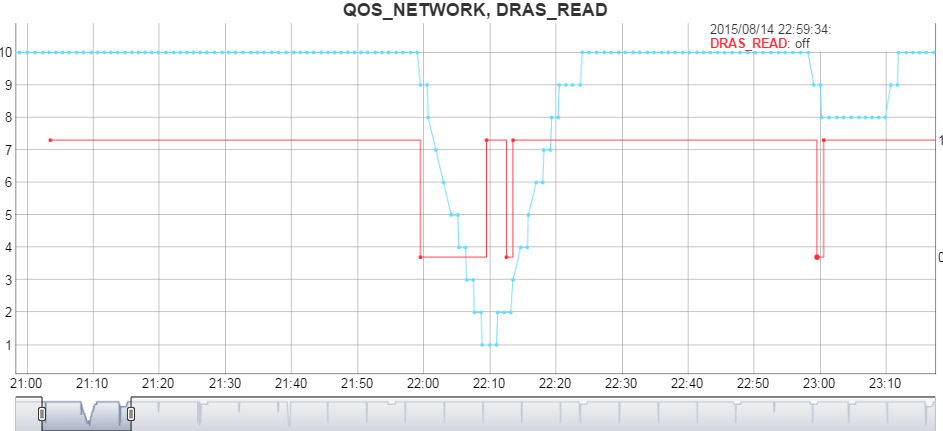How does QOS affect participation?
Quality of Service, score the number of successful polls to the VTN in the last 10 minutes.
QOS or Quality of Service with the VTN is found at the right column of the Home page in GRIDview. QOS is calculated from the DRAS_READ register in a 10 minute running average. Example: If there are 10 successful parses out of the last 10 then the QOS = 10. Six out of the last 10 then QOS = 6 and so on.
If QOS drops to 5 then a warning is indicated as this is considered Low QOS. It must reach 0 or have missed the last 10 parses before a loss of VTN connection is considered to be true. It has been found as End Nodes increase in number Top Nodes can have occasional issues so intermittent failed parses are not uncommon. The customer’s network can also contribute to failed parses.
What does a failure look like?
We can see the performance by clicking the Trend button next to QOS. This graphic has 9 failed parses over a 10-minute period starting at approximately 22:00 hours.
The red line represents the binary True or False logic based on a successful parse. QOS in blue = 1 indicates that there was at least one good parse over the 10-minute period before the communications normalized.
In this case, this would not have affected a scheduled Event because it occurred outside of a normal DR schedule and this particular Utility has a 24-hour notification (see next paragraph).
How does a does a low QOS affect participation in an Event?
Not necessarily. It depends on the Notification Period of your particular program and the maximum duration of sequential parse failures. Here is one example and how it would apply to 3 different DR programs:
The QOS log shows it’s lowest value of 0 over a period of a week. This means there were 10 or more failed parses which lasted a duration of 10 minutes but not longer than 15 minutes in this particular case. We ignore any low QOS logs that occur over a weekend because the DRMS vendors tend to do work at that time and the servers are often Offline for periods longer than 10 minutes.
During a Notification, GRIDlink stores the Start and End times and the Event type in it’s memory so it needs only 1 successful parse in order to participate.
PG&E Simple DR = 24 hour notification. Here there would be no problem.
SCE BIP = 20 minute notification. Here there would be no problem even if the failure occurred exactly at the time of the first notification.
HECO Fast DR = 10 minute. This could present a problem if the failure overlapped the notification period but the GRIDlink would immediately participate upon receiving a successful parse.
Longer periods of failed parses are an indication of network issues. One mitigation would be to provide the customer with a fail over cell connection. This would detect an Internet connection loss and route the connection through a cell provider until the connection is restored. This saves significantly on a costly data plan. Contact us for more information.



